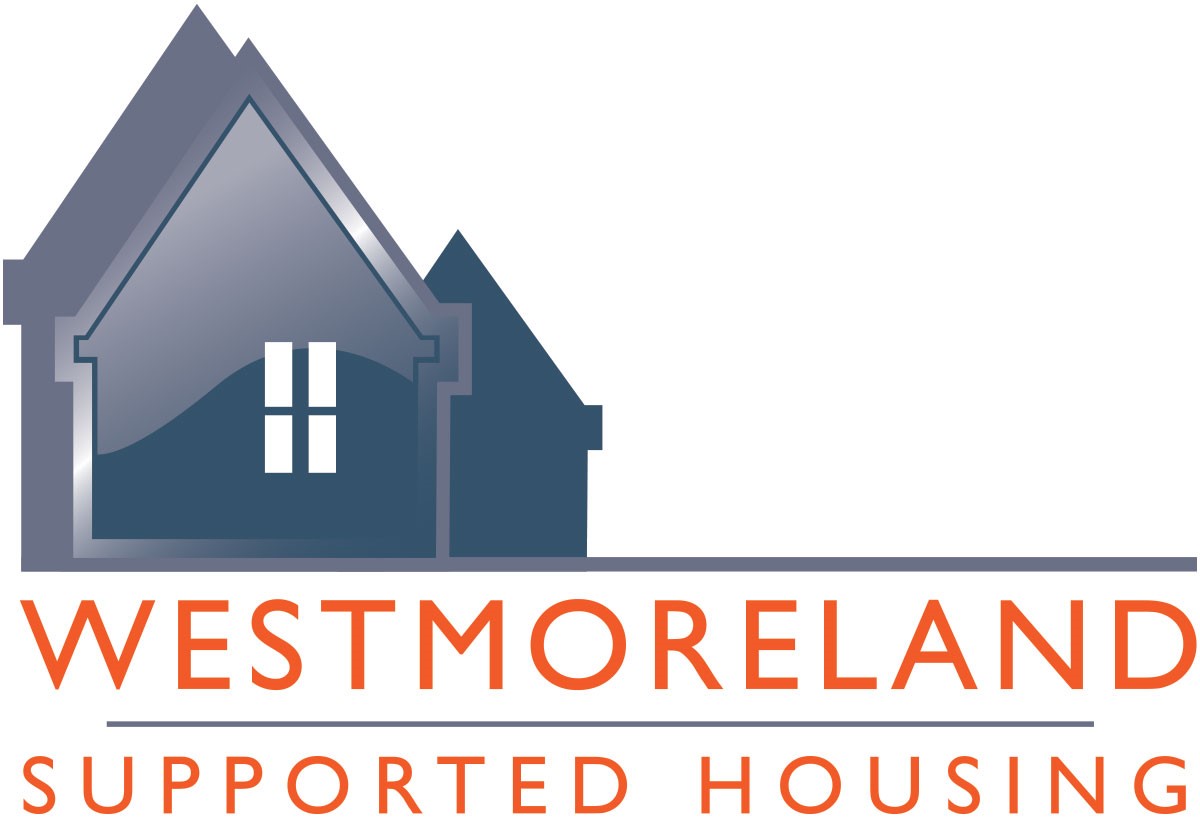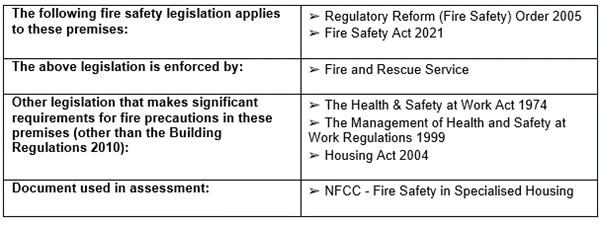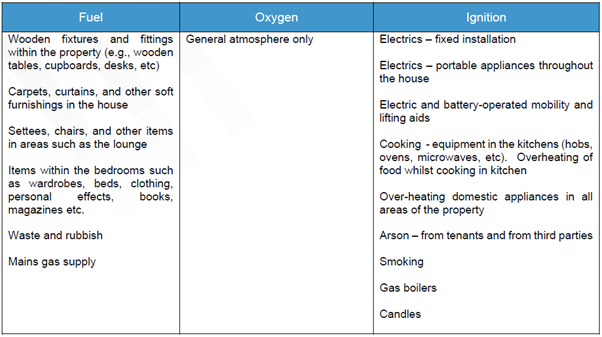Title Page
-
Address:
-
Conducted on
-
Prepared by
-
Property Photos
Fire Risk Assessment
-
Responsible Person / persons having control of the premises
-
Responsible person on site
-
Person consulted at time of assessment
-
Date of previous risk assessment
-
Frequency of FRA (1, 2 or 3 years)
-
Suggested date for review
Disclaimer
-
This fire risk assessment is Type 3 - non-intrusive.
-
In general, the structural features of the premises and those that were hidden from open view e.g. ceiling voids, service ducts etc., may not have been subject to inspection during this fire risk assessment. The Responsible Person has a duty for ensuring that appropriate inspection and maintenance of the structural aspects of the buildings, including the above is carried out.
-
The purpose of this report is to provide an assessment of the risk to life from fire in these premises, and, where appropriate, to make recommendations to ensure compliance with the Regulatory Reform (Fire Safety) Order 2005 and Fire Safety Act 2021. The report does not specifically address the risk to property or business continuity from fire.
-
The Fire Risk Assessment should be a working document, reviewed and updated regularly by the Responsible Person. It may be reviewed for example, following changes to the building, changes in ways of working, following any incident or when there is reason to believe that the risk assessment is no longer valid. Any significant change in areas of mobility or cognitive ability would warrant a review of the Fire Risk Assessment before the due date
-
This assessment report is based on information gathered during the site visit from observations made, documents reviewed and from conversations with people on site. The assessment only covers the areas of the property and/ or activities as detailed within the report.
-
The assessment report has been produced in good faith by a consultant familiar with the assessment process and competent to assess the risk and working in conjunction with other employees and other competent people as necessary. However, there is no guarantee that inspectors with statutory powers will not find other non- compliant issues.
-
Although Westmoreland's consultants are competent to undertake the assessment, the Acts, the Regulations and the Approved Codes of Practice can only be authoritatively interpreted by a court of law.
General Information
-
Number of floors
-
Brief details of external construction
-
Brief details of internal construction and layout
-
Use of Premises
The Occupants
-
Approximate maximum number
-
Associated times/hours of occupation
-
Occupancy Profile
Occupants especially at risk from fire
-
Sleeping occupants
-
Disabled occupants
-
Occupants in remote areas and lone workers
-
Young persons
-
Elderly
-
Other
Fire loss experience
-
Any history of fire loss reported
-
Please give details
Relevant Fire Safety Legislation
Sources of Fuel, Oxygen and Ignition
-
-
Additional sources of Oxygen such as Oxygen tanks
-
Is there sufficient signage in place
Fire Hazards and their Elimination or Control
Electrical sources of ignition
-
Fixed installation periodically inspected and tested?
-
Portable appliance testing carried out?
-
Suitable policy regarding the use of personal electrical appliances?
-
Suitable limitation and management of trailing leads and adapters?
-
Are in-house checks carried out?
-
Are any checks/inspections documented?
-
Comments:
Smoking
-
Reasonable measures taken to prevent fires as a result of smoking?
-
Is smoking prohibited inside the building?
-
Are there suitable arrangements for those who wish to smoke?
-
Did this policy appear to be observed at time of inspection?
-
Comments
Arson
-
Does basic security against arson by outsiders appear reasonable?
-
Is there any unnecessary fire load in close proximity to the premises or available for ignition by outsiders?
-
Comments
Portable heaters and heating installations
-
Is the use of portable heaters avoided as far as practicable?
-
Is the use of the more hazardous type (e.g. radiant bar fires or LPG appliances) avoided?
-
Are suitable measures taken to minimize the hazard of ignition of combustible materials?
-
Are fixed heating installations subject to regular maintenance and documentation available?
-
Is there a carbon monoxide detector provided where necessary?
-
is the carbon monoxide detector tested periodically and are tests documented?
-
Comments
Cooking
-
Are reasonable measures taken to prevent fires as a result of cooking?
-
Are filters cleaned or changed, and ductwork cleaned regularly?
-
Are there suitable extinguishing appliances available?
-
Comments
Lightning
-
Does the building have a lightning protection system?
-
is the lighting protection system inspected annually by a competent person, in accordance with BSEN 62305 and Electricity at Work Regulations and documentation available?
-
Comments
Housekeeping
-
Is the standard of housekeeping adequate?
-
Are combustible materials separated from ignition sources?
-
Has the unnecessary accumulation of combustible materials or waste been avoided?
-
Is there any inappropriate storage of combustible materials?
-
Is there any inappropriate storage of hazardous materials?
-
Comments:
Hazards introduced by outside contractors and building works
-
Are fire safety conditions imposed on outside contractors?
-
Comments:
- Contractors managed by Renov8. No Hot works permitted without suitable risk assessment and method statement in place and strict controls.
Dangerous substances
-
Are the general fire precautions adequate to address the hazards associated with dangerous substances used or stored within the premises?
-
If yes has a specific risk assessment been carried out, as required by the Dangerous Substances and Explosive Atmospheres Regulations 2002?
-
Comments
- Domestic residences. No dangerous substances are used or stored.
Fire Protection Measures
Means of escape from fire
-
It is considered that the building is provided with reasonable means of escape in case of fire.
-
Adequate design of escape routes?
-
Adequate provision of exits?
-
Exits easily and immediately openable where necessary?
-
Fire exits open in direction of escape where necessary?
-
Comments:
-
Avoidance of sliding or revolving doors as fire exits where necessary?
-
Satisfactory means for securing exits?
-
Reasonable distances of travel?
-
Exits and escape routes clear and unobstructed?
-
It is considered that the premises are provided with reasonable arrangements for means of escape for disabled people?
-
Comments
Fire doors
-
Appropriate fire doors are provided where necessary?
-
Are Intumescent strips and smoke seals fitted to three edges of the fire door/frame?
-
Where fitted, are intumescent strips and smoke seals in good condition?
-
Is the fire door and frame in-tact and undamaged? e.g. No holes or repairs?
-
Are self-closing devices fitted to fire doors where necessary?
-
Where glazing is fitted, is it fire resisting?
-
Are there 3 hinges fitted to fire doors?
-
Are hinges on fire doors fire rated?
-
Where necessary, are gaps around the door and frame within the prescribed limits recommended in the NFCC Guide? (4mm max)
-
Where necessary, are gaps between the bottom of the door and the floor covering within the prescribed limits
-
Do all fire doors close fully and fit correctly into the frame/rebate?
-
Where fire doors are held open, are approved devices used? E.g. Door guard?
-
Comments:
Measures to limit fire spread and development
-
Is it considered that compartmentation is of a reasonable standard?
-
Is fire stopping in-tact?
-
Reasonable limitation of linings that might promote fire spread?
-
Comments
Emergency escape lighting
-
Where necessary, is there adequate provision of emergency escape lighting internally and externally?
-
Where emergency lighting is not fitted, are torches provided?
-
Comments:
Fire safety signs and notices
-
Is there a reasonable standard of fire safety signs and notices?
-
Comments:
Means of giving warning in case of fire
-
Is the fire warning provision adequate for the size and use of the premises?
-
Is linked automatic fire detection provided throughout building?
-
Where provided, Is the fire panel indicating healthy with no faults?
-
Is there a zone plan displayed adjacent to the fire alarm panel?
-
Comments:
Manual fire extinguishing appliances
-
Is the provision of portable fire-fighting equipment reasonable? (Fire blankets and extinguishers?)
-
Is firefighting equipment correctly sited and mounted on brackets or stands?
-
Are all fire extinguishing appliances readily accessible?
-
Is suitable signage provided?
-
Comments:
Passenger Lifts
-
Where provided, does the lift returns to ground level on activation of the fire alarm in accordance with BS EN 71-73?Is he lif
-
Where provided is the lift serviced annually and records held
-
Is there suitable signage located next to the lift instructing that it is not to be used in the even of a fire.
-
Comments:
Management of Fire Safety
Procedures and arrangements
-
Are there sufficient competent person(s) appointed to assist in undertaking the preventive and protective measures (i.e. relevant general fire precautions)?
- Yes
- No
-
Comments:
-
Is there a suitable record of the fire safety arrangements?
-
Comments:
-
Are appropriate fire procedures in place?
-
Are procedures in the event of fire appropriate and properly documented?
-
Is there suitable arrangements for summoning the fire and rescue service?
-
Are there suitable arrangements to meet the fire and rescue service on arrival and provide relevant information, including that relating to hazards to fire-fighters?
-
Is there suitable arrangements for ensuring that the premises have been evacuated?
-
Is there a suitable fire assembly point(s)?
-
Are there adequate procedures for evacuation of any disabled people who are likely to be present?
-
Have PEEP’s and Person Centred Fire Risk Assessments been produced where required?
-
Are PEEP’s and Person Centred Fire Risk Assessments reviewed at least annually?
-
Comments
-
Are there sufficient persons nominated and trained to use fire extinguishing appliances?
-
Comments
-
Are there sufficient persons nominated and trained to assist with evacuation, including evacuation of disabled people?
-
Comments
-
All staff are trained on the PEEPs and assisting those residents that need it. Records are kept of training by the head office.
-
Comments
-
Are routine in-house checks/inspections of fire precautions (e.g. in the course of health and safety inspections) carried out and documentation available?
Fire Safety Training
-
Are all staff given adequate fire safety instruction and training on induction?
-
Comments:
-
Are all staff given adequate periodic “refresher training” at suitable intervals?
-
Comments:
-
Does all staff training provide information, instruction, or training on the following?
-
Fire risks in the premises?
-
The fire safety measures in the building?
-
Action in the event of fire?
-
Action on hearing the fire alarm signal?
-
Method of operation of manual call points?
-
Location and use of fire-fighting equipment?
-
Means for summoning the fire and rescue service?
-
Identity of persons nominated to assist with evacuation?
-
Identity of persons nominated to use fire extinguishing appliances?
-
Comments
-
Are staff with special responsibilities (e.g. fire wardens) given additional training?
-
Comments:
-
When the employees of another employer work in the premises (e.g., agency staff) Is it ensured that they are provided with adequate instructions and information?
-
Comments:
Fire Drills
-
Are fire drills carried out at appropriate intervals?
-
Are fire drills fully documented, including time taken to evacuate the building?
-
Do fire drills demonstrate that the premises can be evacuated within 2.5 minutes under normal operating conditions, with the assistance of available staff?
-
Comments:
Testing and maintenance
Fire Alarm
-
Is the fire alarm maintained at least twice per year (once per year for Part 6 alarms - without a fire panel) in accordance with BS 5839-1 by a competent person and is relevant documentation available?
-
Comments:
-
Is the fire alarm system tested from a different call point or detector each week in sequence?
-
Is testing and maintenance documented?
-
Comments:
Emergency Lighting
-
Is the emergency maintained at least annually in accordance with BS 5266-1 by a competent person and is relevant documentation available?
-
Is the emergency lighting tested monthly by operating the test facility for a period sufficient to ensure that each emergency lamp illuminates?
-
Where torches are provided, are they tested regularly?
-
Is testing and maintenance documented?
-
Comments:
Manual fire-fighting equipment (fire extinguishers and fire blankets)
-
Are fire extinguishers and fire blankets inspected by a competent person annually?
-
Comment
-
Are monthly in-house checks of equipment carried out?
-
Is testing and maintenance documented?
-
Comments
Other checks
-
Periodic inspection of external escape staircases and gangways?
-
Where an external metal escape stair is fitted, has a structural survey been carried out within the last 5 years in accordance with BS8210
-
Are regular checks of the condition of the external escape stairs/gangways carried out?
-
Is testing and maintenance documented?
-
Comments:
-
Six-monthly inspection and annual testing of rising mains by a competent person?
-
Is testing and maintenance documented?
-
Comments:
-
Weekly and monthly testing, six monthly inspection and annual testing of fire-fighting lifts by a competent person?
-
Is testing and maintenance documented?
-
Comments:
-
Weekly testing and periodic inspection of sprinkler installations by a competent person and documentation available?
-
Is testing and maintenance documented?
-
Is routine checks of internal fire doors and fire exit doors and / or security fastenings caried out?
-
Are fire door / fire exit door checks and inspections documented?
-
Comments:
Smoke ventilation
-
Is the smoke ventilation system serviced at least once per year in accordance with bs 7346-8 by a competent person and is documentation available?
-
Is smoke ventilation system tested weekly for correct operation?
-
Is testing and maintenance documented?
-
Comments:
-
Are suitable systems in place for reporting and subsequent restoration of safety measures that have fallen below standard?
-
Comments:
-
Other relevant inspections or tests e.g., fire Hoses.
Fire Risk assessment
-
-
-
Taking into account the fire prevention measures observed at the time of this risk assessment, it is considered that the hazard from fire (likelihood of fire) at these premises is:
-
-
Taking into account the nature of the building and the occupants, as well as the fire protection and procedural arrangements observed at the time of this fire risk assessment, it is considered that the consequences for life safety in the event of fire would be:
-
Accordingly, it is considered that the risk to life from fire at these premises is:
Completion
-
Assessors name and Signature:











